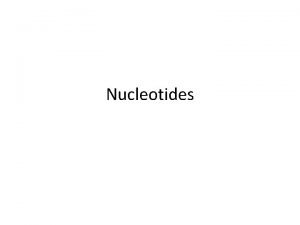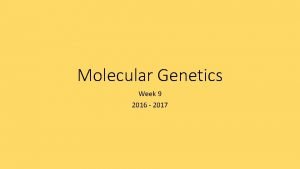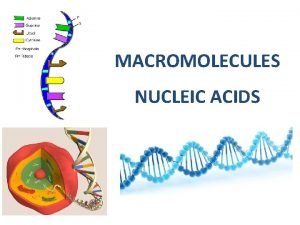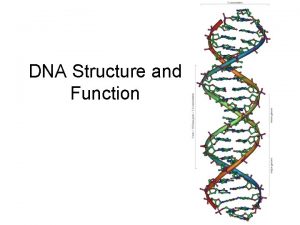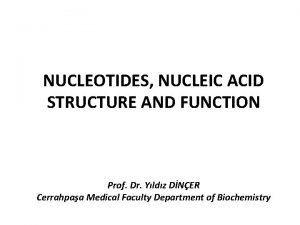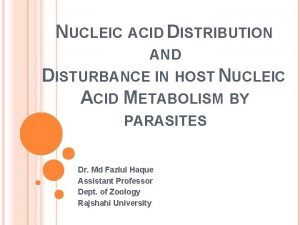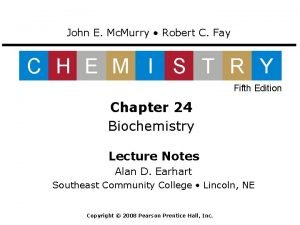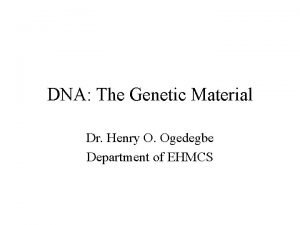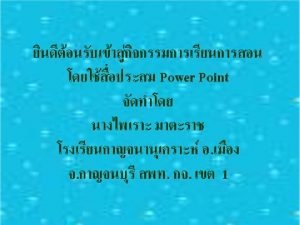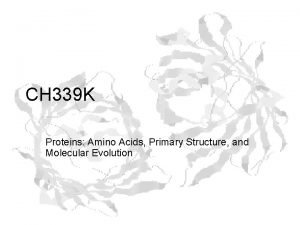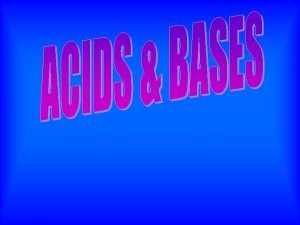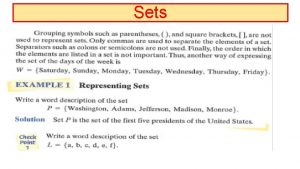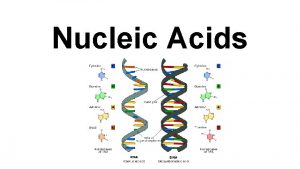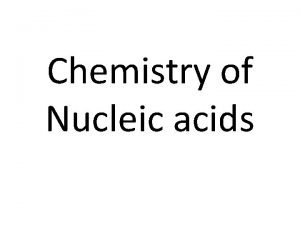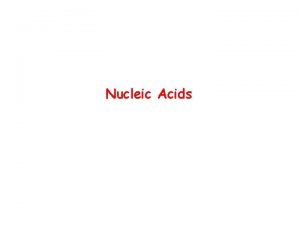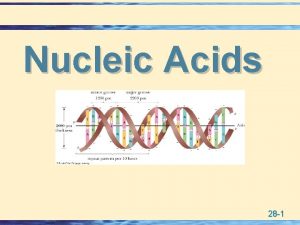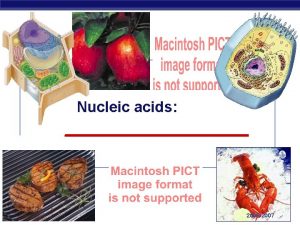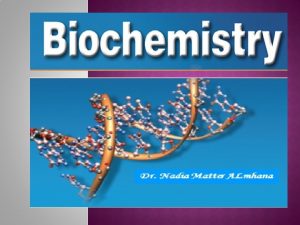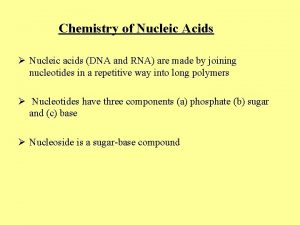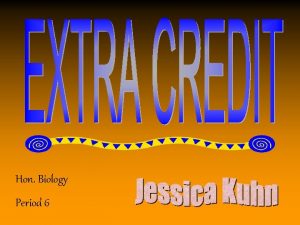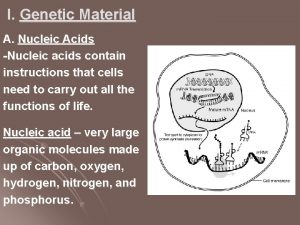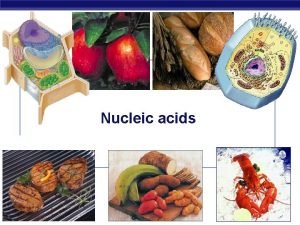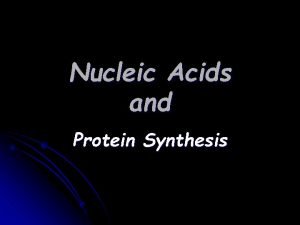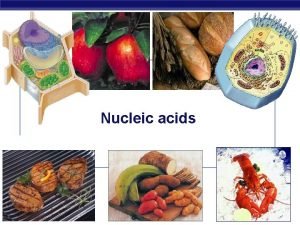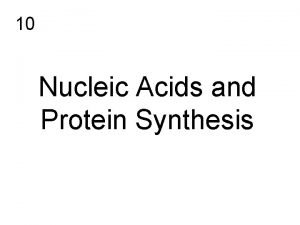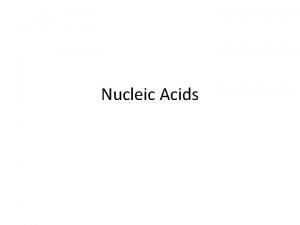Nucleic Acids We have studied three other sets





















- Slides: 21

Nucleic Acids

We have studied three other sets of Macromolecules: Carbohydrates, lipids, & proteins The 4 th macromolecule used by organisms: Nucleic Acids

Two main types: DNA (deoxyribonucleic acid) - found in the nucleus RNA (ribonucleic acid) – found all over the cell DNA functions: • Store genetic information “blueprint” • Transfer genetic blueprint to other generations • Controls many cellular functions RNA functions: • Carries genetic information out of nucleus • Builds proteins

Both types are polymers The monomers are nucleotides RNA is a single strand DNA is a double strand Both have a helix structure

The basic unit for DNA and RNA is a “nucleotide” Composed of 3 parts: 1. a nitrogenous base (1 of 5 types) 2. a pentose sugar (1 of 2 types) 3. a phosphate

Pentose Sugars DNA = deoxyribose RNA = ribose Difference is: Deoxyribose lacks an –OH at 2’ C. Note: 5 th C sticks up from ring

C atoms numbered for orientation: “Primes" distinguish them from atoms of nitrogenous bases. 1’-C –OH group is in a beta ( ) configuration We will be referring to this number system a lot! Particularly note the 5’ and 3’ carbons

Nitrogenous bases of nucleotides • Ring structures of N & C • Plus side chains • Double rings are purines • Single rings are pyrimidines • 5 types provide Note where the carbonyl groups variety in & amines are nucleic acids located

2 purine and 3 pyrimidine bases. Thymine is only in DNA Uracil is only in RNA (but similar to thymine)

Carbon numbering comparison: Purines start at Pyrimidines start upper left Nitrogen at bottom, central Then move Nitrogen counterclockwise and move on 1 st ring, clockwise on 2 nd Sugars start at far right Carbon and move clockwise

Nucleosides and nucleotides A nucleoside forms by combining a nitrogenous base (A, T, C or G) with a pentose sugar. Purine bases: glycosidic bond is N-9 of base and C-1' of the pentose. Pyrimidine bases: glycosidic bond is N-1 of base and C-1' of the pentose.

Nucleotide formation -OH group on 5’ carbon H atom on phosphate OH group

Nucleotide formation H 2 O Condensation reaction or Dehydration synthesis

Nucleotide nomenclature: "5'-monophosphate" suffix – phosphate group attached to 5’ C e. g. "adenosine 5'-monophosphate". Prefix describes the base: purines (double ring) end in –osine pyrimidines (single ring) end in –idine e. g. thymine = thymidine Come on! adenine = adenosine Let it roll off Ribose sugar = no additional prefix the tongue! deoxyribose + adenine = deoxyadenosine

Deoxyadenosine 5' monophosphate Deoxythymidine 5 ' monophosphate

Names of the Eight Nucleotides found in DNA and RNA.

Artificial nucleotides in treating fast growing cancers: 5 -Fluorouracil Fluorinated pyrimidine inhibits DNA synthesis. Tumor cells utilize uracil for DNA synthesis more efficiently than normal cells.

Nucleotide monomers are linked using "phosphodiester bonds" between the 3' C of one sugar to the 5' C of another.

An ester (-O-) is a condensation reaction product of an alcohol (sugars are "polyalcohols") and an acid ( PO 43 - is an acid). H 2 O is a byproduct “Diester" signifies the formation of two ester linkages by each phosphate

The phosphate groups link to the sugars at the 3' and 5' carbons. This is the sugar-phosphate “backbone” of long nucleic acids held together by covalent bonds

Bases are perpendicular to the axis like the steps of a staircase
 Alloburinol
Alloburinol Hystonic
Hystonic What is an anticodon
What is an anticodon Building block of nucleic acid
Building block of nucleic acid Nucleic acid structure
Nucleic acid structure Function of nucleic acid
Function of nucleic acid Ribonucleotide vs deoxyribonucleotide
Ribonucleotide vs deoxyribonucleotide Nucleoside and nucleotide
Nucleoside and nucleotide Function of nucleotides
Function of nucleotides Store and transmit hereditary
Store and transmit hereditary Nucleic acid
Nucleic acid Nucleic acid indicator
Nucleic acid indicator Nucleic acids
Nucleic acids Function of nucleic acids
Function of nucleic acids If you studied hard you would have passed the exam
If you studied hard you would have passed the exam Tp castt poetry analysis answers
Tp castt poetry analysis answers Purpose of traffic signs
Purpose of traffic signs A geometric figure with 8 vertices and 6 faces.
A geometric figure with 8 vertices and 6 faces. How many codons are needed to specify three amino acids?
How many codons are needed to specify three amino acids? Which amino acids have ionizable side chains
Which amino acids have ionizable side chains Acids and bases song
Acids and bases song Acids have a taste and they turn litmus to
Acids have a taste and they turn litmus to
